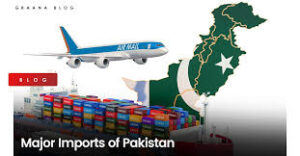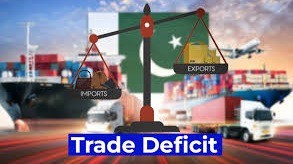
By Munawar Iqbal
EXECUTIVE SUMMARY
The backbone of any country’s economy and its financial strength mainly depends on its exports and external remittances apart from investment and reserves. The same is used to finance the Imports. The main imports of Pakistan make up 19% of the Pakistan’s GDP include: petroleum products (refined petroleum, petroleum gas, and crude oil), Edible oil, Electrical and electronic items, Machinery, Iron, Steel, Pharmaceutical, Organic Chemicals, Vehicles and Defence related products. While, major import partners of Pakistan are China with a market share of 29%, UAE 10%, followed by Indonesia, USA, Saudi Arabia, and other gulf countries and minimal to rest of the World. Our imports in order of percentage is Asia 74%, Europe 10% followed by US, Africa and Oceanic Region.
With this background Pakistan is suffering from a trade deficit as the total imports are greater than exports. The economy of Pakistan is also import dependent which increase the domestic consumption that will increase the trade deficit in Pakistan. A budget deficit occurs when money going out (spending exceeds money coming in (revenue ) during a defined period. In FY 2024, the federal government spent $6.75 trillion and collected $4.92 trillion in revenue, resulting in a deficit. 
Pakistan’s economy remains fragile with deteriorating macroeconomic indicators, hindered by a dependence on imports and low rates of foreign investment, persistently high inflation, red tape, weak rule-of-law, corruption, political uncertainty, security concerns, and long-standing difficulties attracting foreign direct investment.
According to the World Bank Report, the total share of Pakistan in global exports is a mere 0.13 % which is a very negligible amount. While our exports comparatively stand at 9.98% of Pakistan total GDP.
Exports and imports are important because together they make up a country’s balance of trade, which can impact an economy’s overall health. In a healthy economy, both imports and exports see continual growth towards a sustainable and strong economy.
The top twelve commodities that are illegally brought into the country contribute as much as $3.3 billion annually. What’s even more concerning is that law enforcement and regulatory agencies in Pakistan can only seize a small fraction, around 5%, of the smuggled goods entering the country.
Smuggling & its Impacts on Imports
Defined formally, smuggling is the ‘conveyance of things by stealth, particularly the clandestine movement of goods to evade custom duties or import or export restrictions. In general, smuggling involves the employment of illegal means not only to circumvent the trade taxes but it can also make available certain goods that are lawfully banned in a country. Evasion of tariff can partly proceed under the cover of authorized means, such as, through trade under-invoicing, misdeclaration of goods or under/over weighing the products. Moreover, as far as trade restrictions are imposed to protect local industries, smuggling does not let the achievement of this objective possible. There is another aspect of smuggling that by bringing down taxation to affordable levels, particularly the GST, excessive duty rates attract smugglers to intervene.
A substantial amount of smuggling occurs through ports and airports– often by legal importers, who pay taxes and tariffs on some of their wares, but not on all of them. In some contexts, this can provide key competitive advantages for firms connected to political and economic elites. The key enabler here is not necessarily states’ inability to detect smugglers’ wares, but the relationships at ports and customs from which smugglers benefit.
Import strategies:
Implementing a steep reduction in imports through a combination of regulatory duties and import controls, as the government seeks to curtail the current account deficit by around 40% to $10 billion in the next fiscal year. The government will compress the imports through measures that include imposition of regulatory duties on the import of mobile phones and machinery, banning import of cars and increasing duties on the import of auto parts.
To reduce imports in Pakistan, the government can focus on promoting local production by offering incentives like tax breaks and streamlining regulations, developing industrial clusters, investing in vocational training, diversifying export markets, and implementing import controls like tariffs and quotas on non-essential goods, while also prioritizing the import of necessary raw materials for domestic production. Impose Tariffs, import quotas, product standards, and subsidies are some of the primary policy tools that a government can use in enacting protectionist policies.
Trade policy adjustments:
Implement higher tariffs on non-essential imports to make them less attractive; Introduce import quotas to limit the quantity of certain goods entering the country; Utilize regulatory duties to discourage specific imports. The main types of trade barriers used by countries seeking a protectionist policy or as a form of retaliatory trade barriers are subsidies, standardization, tariffs, quotas, and licenses.
Pakistan exports of goods and services as percentage of GDP is 10.47% and imports of goods and services as percentage of GDP is 21.85%.
Pakistan’s imports are consistently higher than its exports, resulting in a trade deficit.
In 2023, Pakistan was the number 45 economy in the world in terms of GDP (current US$), the number 66 in total exports, the number 56 in total imports, the number 170 economy in terms of GDP per capita (current US$) and the number 89 most complex economy according to the Economic Complexity Index (ECI) .
Pakistan recorded a Current Account deficit of 0.50 percent of the country’s Gross Domestic Product in 2024. Current Account to GDP in Pakistan averaged -2.35 percent of GDP from 1980 until 2024, reaching an all time high of 4.90 percent of GDP in 2003 and a record low of -8.50 percent of GDP in 2008.
Conclusions:
Pakistan’s export/import policies and markets are still focused towards US and the West. Whereas the Geo Political environment has changed to multipolar world and new potential markets are now available to be explored.
Pakistan major imports are petroleum products. UAE and Saudi Arabia account for almost 90% share of crude petroleum.4 Similarly, UAE, Kuwait and Oman account for 75% of total share of refined petroleum market. Pakistan buys from the above countries due to many reasons including existing trade relations and deferred payment facility. We need to expand our avenues of oil import to other countries to avoid dependence on one region. Furthermore, the crude oil processing infrastructure of Pakistan is underdeveloped.
The six oil refineries in operation in the country are inadequate to meet the demands of the country. Based on analysis of imports and exports of crude oil and refined oil, Pakistan can enter the new oil import market at relatively low prices of crude oils.
The second most imported product in Pakistan is palm oil which is almost 30%. Pakistan imports palm oil from Malaysia (25%) and Indonesia (75%). We need to find alternatives locally through incentives to our farmers to ease our import expenditures. Pakistan’s other major import are cars and electronic items. Pakistan must focus on its indigenous production through transfer of technology instead of just establishing the assembling plants /factories.
Sources: Pakistan Journal of Applied Economics, Economist, Pakistan Institute of Development Economics, Islamabad, Pakistan. Pakistan Business Council; International Centre of Tax& Development; FPCCI, Trade Facilitation Agreement Database; FBR, MOC, BR, SIFCL SEIC Data; Trading Economies; SBP; PBS, TDAP; STATISTA; PID. (The writer is: Founder Chairman of Pakistan Computer Association & IT Expert. He can be reached at Cell +923008540167, Email: [email protected]). ( This article reflects author’s opinion and not necessarily the views of WNAM )


